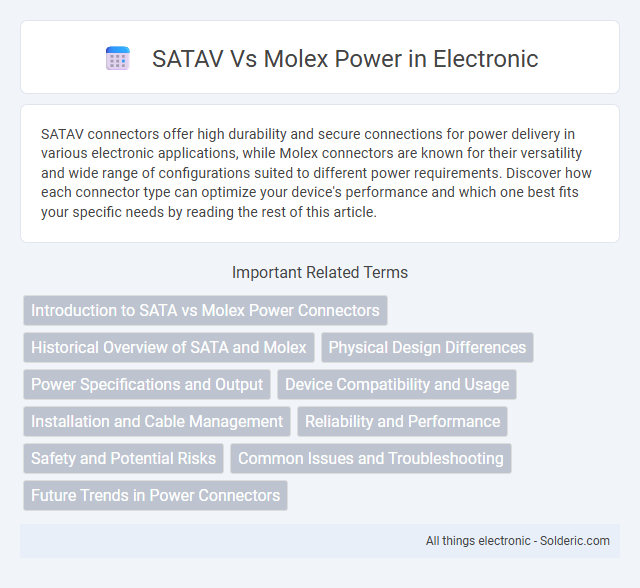SATAV connectors offer high durability and secure connections for power delivery in various electronic applications, while Molex connectors are known for their versatility and wide range of configurations suited to different power requirements. Discover how each connector type can optimize your device's performance and which one best fits your specific needs by reading the rest of this article.
Comparison Table
| Feature | SATA Power Connector | Molex Power Connector |
|---|---|---|
| Connector Type | 15-pin flat connector | 4-pin rectangular connector |
| Voltage Rails | 3.3V, 5V, 12V | 5V, 12V |
| Typical Usage | Modern HDDs, SSDs, Optical Drives | Older HDDs, Optical Drives, IDE devices |
| Power Supply Cable | Thinner, flexible cable with individualized grounding | Thicker wires, no individual grounding |
| Locking Mechanism | Friction lock to prevent disconnection | No locking mechanism, easy to disconnect |
| Current Capacity | Up to 1.5A per pin | Up to 11A per pin |
| Introduction Period | 2003 onwards | 1980s onwards |
Introduction to SATA vs Molex Power Connectors
SATA and Molex power connectors serve distinct roles in computer hardware, with SATA connectors primarily designed for powering modern hard drives and SSDs, offering a 15-pin configuration that supports advanced power management and higher currents. Molex connectors, featuring a 4-pin design, are typically used for older devices like legacy hard drives, optical drives, and some peripherals, providing a simpler connection with 5V and 12V lines. Understanding the differences between SATA and Molex power connectors can help you ensure compatibility and stable power delivery in your PC build or upgrade.
Historical Overview of SATA and Molex
SATA and Molex power connectors have distinct historical roots influencing modern PC hardware. SATA power connectors emerged in the early 2000s, designed to replace the legacy Molex connectors by providing a more efficient, hot-swappable interface mainly for hard drives and optical drives. Molex connectors, established in the late 1950s, have been a long-standing standard for powering various computer components, favored for their robust and simple design despite lacking the advanced capabilities offered by SATA interfaces.
Physical Design Differences
SATAV connectors are designed with a flat, L-shaped profile that ensures a secure connection for SATA power cables, minimizing space usage inside computer cases. Molex connectors feature a bulkier, rectangular shape with four large pins, ideal for delivering power to legacy components such as older hard drives and optical drives. Your choice between SATAV and Molex should consider the physical dimensions and compatibility with your hardware setup for optimal power delivery and cable management.
Power Specifications and Output
SATAV power connectors typically provide 12V and 5V outputs suitable for SATA devices, with a maximum current rating of around 1.5A per line, ensuring stable power delivery for storage drives. Molex power connectors offer a 12V and 5V output as well, but can supply higher current, often up to 11A on the 12V line, making them ideal for components with higher power demands like fans or legacy hardware. Understanding these power specifications and output capabilities helps you choose the right connector to match your device's power requirements efficiently.
Device Compatibility and Usage
SATAV connectors are specifically designed for SATA devices, ensuring optimal power delivery to hard drives and SSDs commonly found in modern desktops and laptops. Molex power connectors offer broader device compatibility, supporting older IDE drives, fans, and various peripherals, making them versatile but less specialized for SATA storage devices. Your choice depends on the type of hardware you intend to power, with SATAV ideal for newer SATA components and Molex suitable for legacy or diverse internal devices.
Installation and Cable Management
SATAV connectors offer a more secure and snap-in design that simplifies installation and reduces the risk of accidental disconnections compared to Molex power connectors, which use a friction-fit mechanism requiring careful alignment during assembly. Cable management is streamlined with SATAV due to their compact form factor and keyed configuration, allowing for neater routing and reducing cable clutter inside chassis, while Molex connectors tend to be bulkier and less intuitive in orientation, potentially leading to tangled or obstructed cabling paths. The enhanced locking mechanism of SATAV also minimizes cable strain and improves system reliability in high-vibration environments, a critical factor in maintaining clean and stable cable arrangements.
Reliability and Performance
SATAV connectors offer enhanced reliability with superior resistance to vibration and corrosion, making them ideal for demanding power delivery applications. Molex power connectors are known for consistent electrical performance and robust contact design, ensuring stable current flow and minimal signal loss. Your choice between SATAV and Molex should consider the specific operational environment and required durability to maximize system performance.
Safety and Potential Risks
SATAV connectors offer enhanced safety features with improved insulation materials and secure locking mechanisms, reducing the risk of accidental disconnections and electrical shorts. Molex power connectors are widely used for their reliability but may pose higher risks of overheating and wear over time if not properly maintained. Understanding each brand's design standards and usage scenarios is crucial for minimizing potential electrical hazards in power connections.
Common Issues and Troubleshooting
Common issues with SATAV and Molex power connectors include loose connections, bent pins, and cable wear that lead to intermittent power delivery or total failure. Troubleshooting involves inspecting connectors for physical damage, ensuring cables are firmly seated, and testing with a multimeter to verify voltage continuity. Replacing damaged cables or connectors often resolves the power issues affecting your hardware's stability.
Future Trends in Power Connectors
SATAV and Molex power connectors are evolving to accommodate higher data transfer rates and increased power efficiency in next-generation electronics. Innovations include integrating smart sensor technology for real-time monitoring and adopting robust materials to enhance thermal management and durability. The future of power connectors emphasizes miniaturization and seamless compatibility with emerging industry standards like USB4 and PCIe 5.0.
SATAV vs Molex power Infographic

 solderic.com
solderic.com